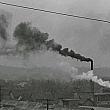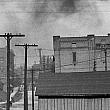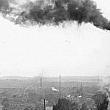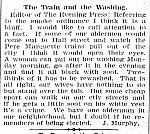What Happened to the International Association for the Prevention of Smoke?
At A&WMA's headquarters office in Pittsburgh (originally the International Assoc. for the Prevention of Smoke ), the walls of the library are lined with a range of publications that document the history of the Association. Included in those aging tomes are proceedings from the Association's earliest annual meetings, some of which are so old and worn that they are held together with adhesive tape.
Although their covers are a little worse for wear, the inside pages clearly show how, for the past century, the Association has played a vital and leading role on air quality and waste management issues. Did you know, for example, that the active membership of the association was first limited to municipal smoke inspectors? For a time, it was. In the early 1900s, smoke - primarily from factories and trains - was an emerging environmental nuisance and public health hazard. As industrial cities grew, they passed new coal-burning ordinances and required city smoke inspectors to be trained in mechanical engineering. To share effective smoke-control strategies, inspectors from cities around the world called for the formation of an association on an international scale. Out of this, in 1907, the first official meeting of the International Association for the Prevention of Smoke, the forerunner to A&WMA, was held.
 In 1913, the Association expanded membership to include not just smoke inspectors, but also all individuals interested in the advancement of smoke prevention. Still, for the next few decades, the Association's membership remained closely associated with coal and its usage.
In 1913, the Association expanded membership to include not just smoke inspectors, but also all individuals interested in the advancement of smoke prevention. Still, for the next few decades, the Association's membership remained closely associated with coal and its usage.
However, as the art and science of air pollution control expanded, so did the Association's outreach, broadening to include smoke abatement, fuel conservation, and health preservation. For decades, the Association experienced consistent and dramatic growth fueled by the need for a neutral forum on public education, technology exchange, and outreach to environmental professionals.
As the organization evolved, the name was changed to the Smoke Prevention Association (1940), the Air Pollution and Smoke Prevention Association of America (1950), and the Air Pollution Control Association (1952).
By the 1970s, environmental awareness had broadened, and the then-named Air Pollution Control Association continued to lead the way with educational efforts aimed not only at reducing air pollution, but also at addressing the growing problems of hazardous wastes. On the heels of these efforts, new federal legislation was passed to address the threats of hazardous wastes.
Because a growing number of members were spending time on waste management issues, the Association resolved in 1984 to implement a sustained and coordinated program to meet the needs of environmental professionals in the general areas of hazardous wastes and toxic substances. By the end of the decade, the Air & Waste Management Association was born.
Excerpted from the A&WMA website

 facebook
facebook









